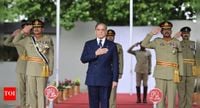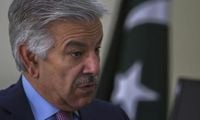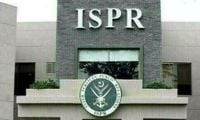On October 4 and 5, 2025, the already fraught relationship between India and Pakistan reached new heights of tension, as senior military and political figures on both sides exchanged some of the most severe public warnings in years. In a series of sharply worded statements, Pakistan’s military and government leaders condemned what they called “delusional, provocative and jingoistic” remarks from the highest levels of India’s security establishment. They warned that any future conflict could result in “cataclysmic devastation” and promised a response that would be “swift, decisive and destructive.”
The trigger for this latest rhetorical escalation was a sequence of comments by Indian officials, including Defence Minister Rajnath Singh and Army Chief General Upendra Dwivedi. Singh, addressing troops at Bhuj Military Station on October 2, declared that India could cross any border whenever necessary to protect its citizens and safeguard its “unity and integrity.” He specifically warned that any "misadventure" by Pakistan in the disputed Sir Creek sector would invite a “decisive response” capable of changing both “history and geography.” Sir Creek, a 96-kilometer tidal estuary between Gujarat and Pakistan, has long been a flashpoint due to conflicting interpretations of the maritime boundary.
General Dwivedi’s remarks, delivered to soldiers near the Pakistan border on October 3, were even more direct. He cautioned Islamabad to “stop sponsoring terrorism” if it wished to “retain its place on the world map,” and made clear that India would not repeat the restraint it had shown during the May 2025 conflict. Instead, he urged Indian soldiers to remain ready for action, suggesting that any future provocation would meet with overwhelming force. "The restraint shown by New Delhi during Operation Sindoor would not be repeated in case of a future military conflict," Dwivedi warned, as reported by PTI.
Adding to the pressure, Indian Air Chief Marshal AP Singh claimed that at least a dozen Pakistani military aircraft, including US-origin F-16 jets, had been destroyed or damaged during Indian strikes in Operation Sindoor. “Operation Sindoor was launched with a clear and limited objective and terminated promptly once those aims were achieved,” Singh said, highlighting the extensive damage inflicted on Pakistan’s airfields, radars, and command centers while minimizing collateral damage.
These statements came in the wake of the brief but intense conflict in May 2025, which was triggered by a deadly attack on Hindu tourists in Indian-administered Kashmir. India blamed Pakistan for sponsoring the attack, which killed 26 civilians—the worst such incident since the 2008 Mumbai attacks. In response, India launched Operation Sindoor on May 7, targeting what it described as terror infrastructure in Pakistan-controlled territories. The operation resulted in four days of missile, drone, and artillery strikes, with both sides claiming to have inflicted heavy losses. India said it had destroyed militant facilities and killed over 100 Pakistani soldiers and militants, while Pakistan claimed to have shot down six Indian fighter jets, including French-made Rafales—a claim India denied, acknowledging only some losses.
The fighting ended on May 10 after US mediation brokered an uneasy ceasefire, but the episode left both countries’ leaderships under domestic and international scrutiny. According to Business Recorder, the May 2025 clashes brought the two nuclear-armed neighbors “to the brink” of a major war, and the fallout continues to reverberate across diplomatic, economic, and even sporting ties.
Pakistan’s response to the latest Indian rhetoric was swift and uncompromising. On October 4, the Inter-Services Public Relations (ISPR), the media wing of Pakistan’s military, issued a communique condemning Indian officials’ statements as “irresponsible” and “an attempt to fabricate arbitrary pretexts for aggression.” The ISPR asserted, “In the face of highly provocative statements of the Indian Defence Minister and its Army and Air Chiefs, we caution that a future conflict might lead to cataclysmic devastation. In case a fresh round of hostilities is triggered, Pakistan shall not hold back. We shall resolutely respond, without any qualms or restraint.”
Pushing back against Indian threats of “erasing Pakistan from the map,” the ISPR warned that any such scenario would be “mutual.” The statement emphasized that Pakistan’s armed forces have the capability and resolve “to take the fight to every nook and corner of the enemy's territory.” This language, analysts noted in Business Recorder and other regional outlets, signals a “new normal of response” from Islamabad—one that promises immediate and overwhelming retaliation for any perceived aggression.
Pakistan’s Defence Minister Khawaja Muhammad Asif amplified this message on October 5, taking to social media to call Indian leaders’ remarks a “failed attempt to restore their lost credibility” after what he described as a decisive defeat in May 2025. “After such a decisive defeat with a score of 0–6, if they try again, the score god willing will be much better than before. … This time India will be buried under the wreckage of its own planes,” Asif wrote, though he did not elaborate on the meaning of the “0–6” scoreline. Asif’s tone echoed the ISPR’s, promising a “befitting response” to any future hostilities.
The rhetoric on both sides has not gone unnoticed by the international community. Western capitals and international mediators have repeatedly urged restraint, warning that miscalculation between two nuclear-armed states could have “unacceptable humanitarian and strategic costs.” The ISPR statement itself framed the situation as a cautionary tale for the region, stressing the need to avoid political and military posturing that could spiral into real conflict. Yet, as analysts cited by BBC and PTI pointed out, the stark language and threats risk hardening public perceptions and narrowing the diplomatic space for back-channel crisis management.
Underlying the war of words is a deep and persistent mistrust. India accuses Pakistan of supporting cross-border terrorism, while Pakistan frames India’s actions as attempts to “play the victim card” and foment regional instability. Since the May 2025 clashes, diplomatic ties have been downgraded, with the impact felt in trade, travel, and even sports. Both nations remain at a virtual diplomatic standstill, trading accusations and ramping up military postures along the border.
As tensions simmer, the region and the world watch anxiously, hoping that the rhetoric does not give way to renewed conflict. The specter of nuclear escalation looms large, and the stakes for South Asia—and beyond—could hardly be higher.


